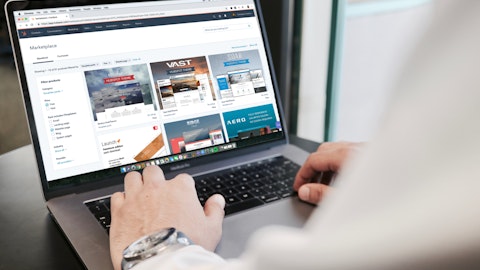Jesse Singh: I would say the data and the sentiment is very similar over the last few — almost over the last, I guess, over a year of surveys. Some of the froth that we may have felt is — has normalized. And so now we’re sitting at an above-average backlog for most contractors. And I think there’s really two elements to that, right? Pete mentioned the weeks of backlog, which has varied between seven and eight in that range. It’s seven and change right now. But we also ask those same contractors their assumption of growth and their sentiment beyond just the number of backlogs or the number of weeks of backlog. And in general, that’s what you see as being incrementally more positive. So the combination that affects us, stable business, much more normalized, good activity and a pretty good — we’re using the word cautiously optimistic view of what’s ahead of them.
John Lovallo: Okay. That’s helpful. And then I think in terms of SG&A in the quarter, Pete, you called out higher stock comp and continued investment. As we think about SG&A as we move through this year, and maybe into next year, I mean, is the right way to think about it still slight de-leveraging this year and then maybe a return to positive operating leverage in 2025?
Peter Clifford: I think we’ll probably look at ’24 as kind of a more neutral year from a leverage perspective on SG&A. And then I would think that we feel pretty passionately that beyond this year, most years, we got to get back to getting 25 bps of kind of SG&A leverage per year with growth back to double digits.
Operator: And our next question comes from the line of Susan Maklari with Goldman Sachs.
Susan Maklari: My first question is on the exterior side again. You mentioned that you started a new facility, I think, outside Pittsburgh in the quarter. Can you talk a bit more about that facility and how we should think about it coming online and what it could mean for growth in that part of the business?
Jesse Singh: Yes. Good question. So we have a facility in Aliquippa, which is our Versatex facility. It does make products broader, but it is the original Versatex facility. In essence, we have property and we are doubling the size of that facility by building a similar-size building nearby. Within that building, we will have — and we didn’t disclose a specific completion date, except to say that, that is where some of the capital is going. That building will have the ability to do siding profiles, which are part of our exteriors business, and trim, traditional trim, sheet trim. And so in essence, what it does is it gives us both new product capacity for some of our new siding and other profile products in addition to giving us capability to service future growth against our exteriors business. And once again, the benefit of the way in which we operate is we’re always allocating a portion of our capital to incremental new products and incremental capacity.
Susan Maklari: Okay. That’s helpful color. And then shifting gears a bit. As you think about the cash generation of the business that’s expected this year and some of the perhaps priorities for that, can you talk a bit about your appetite for further repurchases post the ASR? Any updates on the M&A pipeline and what you’re seeing there or any changes to your appetite for deals?
Peter Clifford: Yes. I’ll take the repurchases piece of it, Sue. Ultimately, look, we do expect another year of strong flow of cash from ops as well as free cash flow. You should expect us to continue to be, at times, I’ll call it programmatic at our share repurchases through the balance of the year, but withholding right to also be opportunistic if we saw any dislocation. And I think if we exceed our cash generation ambitions this year, I think we would even consider later in the year being additive to repurchases with possibly looking at some debt retirement.
Jesse Singh: And then on the M&A front, as we’ve talked about, we’ll continue to evaluate appropriate opportunities. We’re always in the market. We’re always chatting with folks. We certainly believe that there’s an opportunity to continue to build out our product portfolio in an appropriate way. But it’s got to be the right time, and we’re going to be very selective that anything we do will not alter our investor deck in terms of market focus, in terms of margins, in terms of what we want to do moving forward. I will highlight that underneath or as we look at the business, we recognize that as we move throughout the year, this business is now in a terrific position to generate a fair amount of cash. And we’ve got a fair amount on the balance sheet right now even post ASR, and we’ll continue to be in a good position of generating cash, which gives us a lot of optionality on the appropriate way to deploy it as both organically against the business, selectively on M&A opportunities.
And then we have a lot of options relative to how we want to manage the balance sheet as we pointed out.
Operator: And our next question comes from the line of Mike Dahl with RBC Capital Markets. Mike, please go ahead.
Mike Dahl: A lot of my questions have been answered, but maybe just one more. Sorry to beat the horse on kind of the implied cadence. But if I hear the comments, you’re talking about improved sentiment, no indicators, and digital could suggest that anything has really changed recently. The second half implied guide is still relatively modest. So, is the right way to think about this that if what you’re seeing today holds, that would be upside to your guidance in the second half, i.e., your guide implies that conditions ultimately moderate versus what you’re seeing in the early buy season?
Jesse Singh: Yes. The way I would word it, we have seen double-digit sell-through growth, and we’ve seen that for a reasonable period of time. You heard us talk about that last summer, and we have continued to talk about that to this point. That’s what we have seen, and our guide implies mid-single-digit growth. And we think that’s appropriate given that the season hasn’t started, and we can give you the assumption of a flat R&R with our initiatives on top of that. If something changes, then obviously, that would have an impact on certainly the midpoint of what we’re talking about.
Mike Dahl: Got it. Okay. And then, obviously, you had some nice share wins last year that you’ve articulated. I guess, as you’ve gone through the past couple of months, anything that you’re seeing on the pro or retail side in terms of kind of additional opportunities or additional wins that might layer in through the year?
Jesse Singh: Yes. As we mentioned on the call, it’s pretty typical this time of the year, we go through a negotiation on shelf space, new products and positioning ourselves in the marketplace. As I mentioned on the call and as Pete mentioned, we feel really, really good about our incremental opportunity. That is an outcome of those discussions. And I think the most important thing for us is we want to drive more growth in the marketplace. We want to drive more conversion in the marketplace. We want to expand our brand, supercharge it, if you will. And I think it’s really, really a terrific opportunity. And these things that we just — the discussions we’ve just gone through have created an opportunity for us to continue to drive broader conversion and be able to continue to expand in the marketplace.
Operator: And our final question today comes from Rafe Jadrosich with Bank of America. Rafe, please go ahead.
Rafe Jadrosich: Great. Peter, if I look at the EBITDA guide for the year, I think it’s about $70 million growth at the midpoint. Can you just help us bridge that growth? I think it’s about $30 million from costs. It seems like price is neutral, SG&A is neutral. Just can you help us bridge to that $70 million?
Peter Clifford: Yes, Rafe. This is Peter. I mean as we had communicated before, you got about $20 million of kind of underutilization in the first half of the year. That’s a piece of that. You’ve got, let’s call it, deflation of kind of close to $30 million and the rest being sort of the flow-through on the additional sales kind of offset by — at a macro, the disposition of the Vycom business. Those are the biggest pieces.
Rafe Jadrosich: Got it. That’s very helpful. And then just on the change in your…
Jesse Singh: And Rafe, if I could just highlight, under the surface — and we tried to stress this. We still have a lot of opportunity ahead of us. But we have also been progressing over the last two years. And some of the kind of the combination of underutilization and having elevated supply chain cost has masked some of what was underneath. And so what Pete’s highlighting is it’s just, in effect, a more normal cadence, which can then let the underlying capability of the business come out. I’m sorry. You had another question.
Rafe Jadrosich: That’s really helpful. Just on the change in guidance from last quarter, sales are going up, I think, at the midpoint around $50 million. And then EBITDA is going up, I think, $40 million at the midpoint. So, the margins on the incremental sales that you’re getting is really high. Can you just help us understand like why it’s so high relative to where it’s going to be?
Jesse Singh: I would separate those two. I would look at it as, there’s incremental sales that have an incremental benefit. And I think in the past, we’ve talked about that incremental flow-through of 30% to 40%. It’s probably closer to 40% right now. And then there’s the base amount of activity that, as Pete pointed out, we felt really good about our ability to drive higher margins on the business we already had. But we wanted to see a few more cards before we took off the constraints or took off some of the constraints. Obviously, we’re always risk adjusting our activity. But we have much, much better visibility on the underlying margin capability of the core business. So I would just separate the two. There’s some incremental benefit from incremental sales. But even if we had not guided sales up, what we can see on the margin side would certainly have been guided up just based on the execution we see of the core business.
Peter Clifford: And I’d just add, we’re in an environment right now where extra sales means extra production, which means leverage in the plants. It means extra recycling activity, which means extra recycling impact. If we’re buying more, we’re getting more deflation. So, we’re in a pretty enviable position right now whenever we get additional revenue. It’s very supportive of that incremental 40% flow-through rate.


